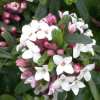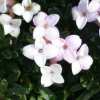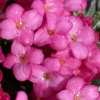| DAPHNE x napolitana 'Enigma' The original hybrid between D. collina and D. cneorum. A superb small rounded bush, making approx. 1m by 1m. Masses of bright pink flowers in summer and sporadically through the year. Indeed, last year they started in March and continued through to November. Following the nomenclature in Robin White's recent monograph, this, the original clone has been given the cultivar name 'Enigma'. |
||
|
|
||
| DAPHNE x napolitana 'Bramdean' (D. collina x D. cneorum var. pygmaea) Another pretty small evergreen with intensely fragrant pink flowers in April-May. Potentially 9" x 2'. A lovely tidy plant, but still with enough vigour to actually grow well. An excellent combination. |
||
|
|
||
| DAPHNE x napolitana
'Meon' (D. cneorum x D. collina) Once more hybrid vigour gets this plant off to an excellent start. The flowers are one of the largest of all our Daphnes, being pink in colour and fra grant of course. Expect 12-15" high by 2-3' across. |
||
|
|
||
|
DAPHNE
x napolitana 'Stasek' A very limited number of this variegated clone will be available this year. It has considerably larger leaves than the usual forms (both variegated and green) and seems to be bushier and less spreading. Previously listed as a cultivar of D. cneorum, it has good vigour and does well. Recently, Robin White announced that in his opinion it is more likely a hybrid, between (he suggests) D. cneorum and D. collina, making it a selection of D. x napolitana. |
||
|
|
||
|
||
|
|
||
| DAPHNE odora Bushy to 1.5m with glossy leaves. Wonderful scented white flowers open from pink buds in winter and early spring. Hardy in most parts of the country, but surprisingly the variegated form below is actually considerably hardier. |
||
|
|
||
| DAPHNE odora
'Aureamarginata' Dark pink buds open to pale pink flowers in March which are wonderfully fragrant. The glossy dark green leaves are narrowly margined yellow. This must be one of the most sought after of all flowering shrubs. |
||
|
|
||
 |
DAPHNE odora 'Double Cream' We selected this highly variegated sport here. The margins are a broad creamy white with a slightly grey green centre. Given a shady site on good soil it grows well and flowers as magnificently as it's better known cousin (which is rarely well variegated.) |
|
|
|
||
| DAPHNE odora
'Rubra Variegata' The variegation is bolder than Aureamarginata, and the flower buds are a much deeper pink, opening paler. This gives an attractive bicolour effect across the plant. |
||
|
|
||
| DAPHNE odora
'Sakiwaka' We have long been searching for the white form. Numerous purchases of D.odora 'Alba' or 'Leucanthe' (which are supposedly synonymous) have resulted in disappointment at the pink flower. This Japanese form however, does have pure white flowers contrasting well with the glossy green leaves. In fact, there is almost a tinge of yellow in the tight buds. This plant responds well to regular feeding through the growing season to maintain the lustre of the leaves. Sold out |
||
|
|
||
| DAPHNE
oleioides An unusual dwarf with leathery, almost glaucous leaves. The creamy fragrant flowers occur in terminal clusters in summer. Red fruits. |
||
|
|
||
 |
DAPHNE 'Perfume of Spring'
(D. caucasica x D. petraea) |
|
|
|
||
| DAPHNE petraea 'Corna Blanca' | ||
|
|
||
| DAPHNE
petraea 'Grandiflora'
Perhaps the archetypal alpine Daphne and one we've never been able to offer before as it is so slow growing that we've never dared to take material from our stock plant. Intense pink flowers literally smother the plant, opening deep reddish pink, fading with maturity. |
||
|
|
||
| DAPHNE petraea 'Lydora' | ||
|
|
||
 |
DAPHNE
petraea NES 99-63 Perhaps my favourite (at present!) of all our alpine Daphnes. See the photo on our website to see why. The tiny leaves are the richest green and really show off the gorgeous apple-blossom coloured flowers. I dare say that in the fullness of time this wild selection will be given a proper cultivar name. |
|
|
|
||
 |
DAPHNE
petraea 'Persebee' Although the same species, this selection is quite different, being small and dumpy with even tinier leaves and seemingly disproportionably large pink flowers. |
|
|
|
||
| DAPHNE
'Pink Star' (D. x burkwoodii 'Somerset' x D. cneorum 'Eximia') Intermediate between its parents, this pretty plant will create a vibrant splash of colours in any border when it flowers in April-May. Dusky pink buds open to reveal highly scented paler flowers, which darken again as they mature. Pinching strong shoots when young will help to initiate a bushy plant. Expect 30-45cm x 60-90cm wide. |
||
|
|
||
| DAPHNE pontica hybrid This Daphne came to us as D. pontica and indeed we sold it as such last year. However, it has now flowered and those flowers were not quite spidery enough to be true pontica. They are more like the "typical" Daphne flower in shape and a delightful greeny yellow in colour. They are produced in April-May and were also quite definitely scented. Blue black fruits. Sometimes referred to as the "Evening Daphne" it is moth pollinated, so will give best scent in a west facing site - ie in evening sun. The leaves are pontica like in shape but a particularly healthy deep green in colour. It must be a hybrid from pontica, but we are not yet certain what with! However, it remains an exceptionally fine plant being unusually tolerant of heavy shade and heavy clay! The spidery yellow flowers in April-May are very attractive. |
||